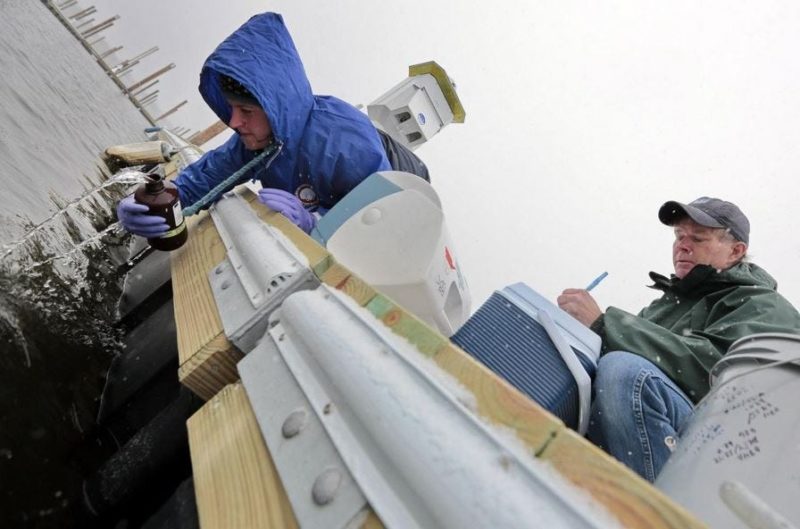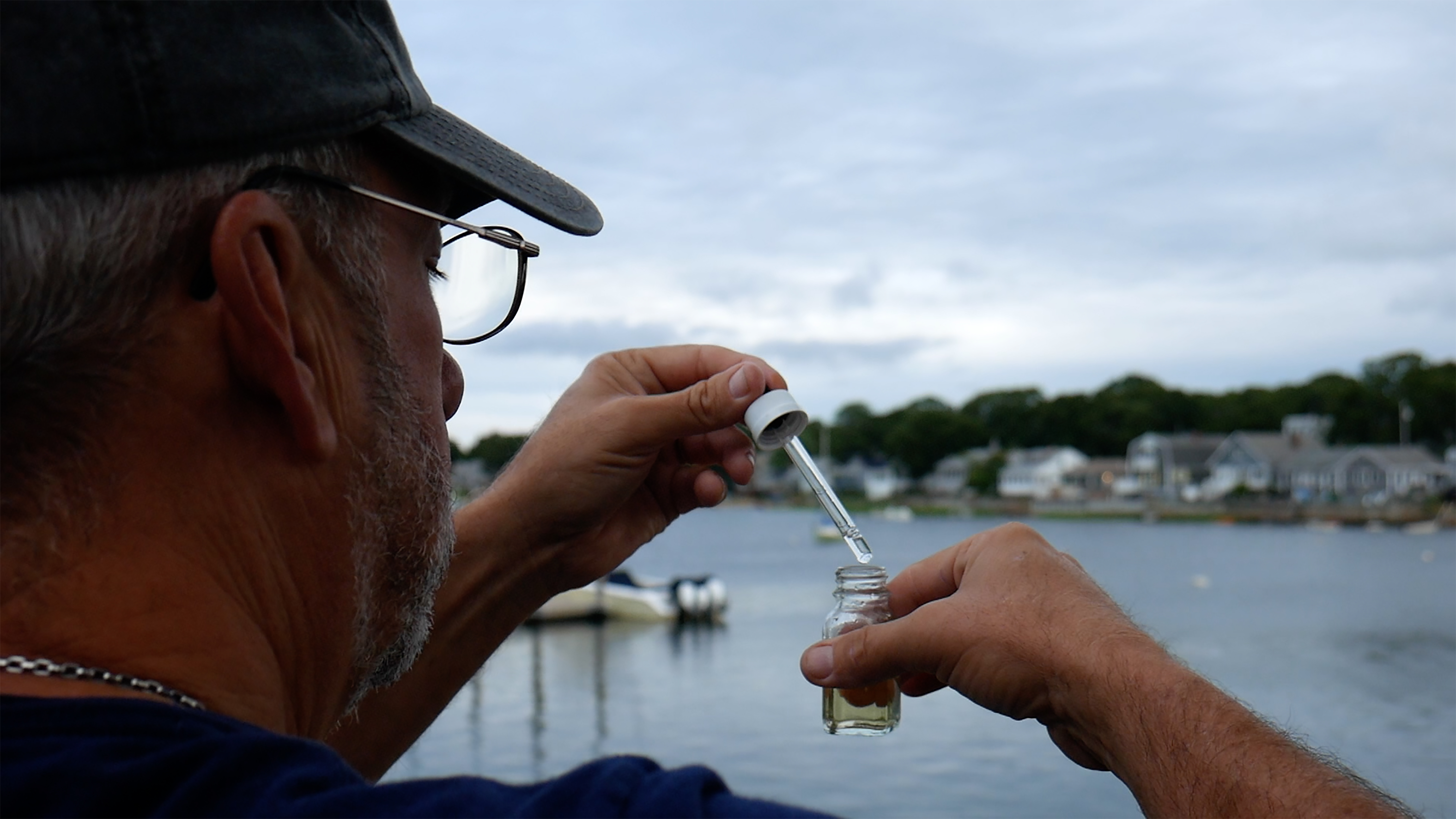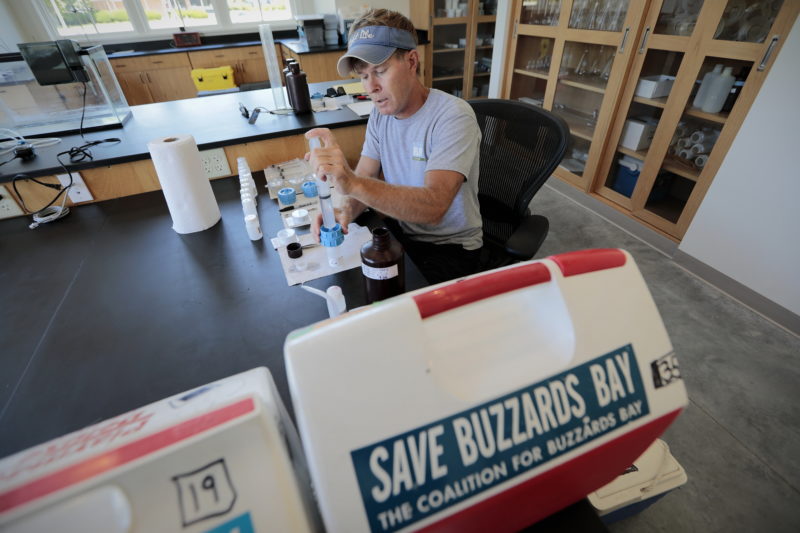Coalition seeding new scientific investigations into Bay restoration with broad publication of 27-year water quality record
On the eve of the program’s 30th anniversary, the Buzzards Bay Coalition just published the first 27 years’ worth of its Baywatchers water quality data in the international scientific journal, Scientific Data. Publication will improve access to the information for researchers around the world who may use it to develop new insights into protecting Buzzards Bay and other coastal waterways.

Coalition Science Director Rachel Jakuba and Tony Williams, director of monitoring programs, collect a water sample for the Baywatchers water quality monitoring program. [ PETER PEREIRA/THE STANDARD-TIMES/SCMG ]
“It’s gratifying to see the Baywatchers data published, and it’s exciting to think about how it may inspire new studies,” said Rachel Jakuba, Ph.D., science director of the Coalition and the lead author of the journal article. “We hope getting this data out in an open-access, peer-reviewed journal will encourage scientists to use it to test new hypotheses and develop new insights into Bay health.”
The data collected through the Baywatchers Monitoring Program come from a unique partnership involving local citizen scientists, professional scientists, and two internationally renowned research institutions—Marine Biological Laboratory and the Woodwell Climate Research Center—coordinated by the Buzzards Bay Coalition, which founded the Baywatchers program in 1992.

Baywatcher Earl Deagle analyzes a water sample collected from the Broad Marsh River in Wareham.
Coalition staff and citizen scientists (residents who have been trained) collect water quality information at more than 200 stations around the Bay each summer, from May through September, managed by Tony Williams, the Coalition’s director of monitoring programs. Data document the effects of nitrogen pollution including low oxygen that threatens marine life. Water samples are analyzed at the MBL in Woods Hole, under the direction of Woodwell Center Senior Scientist Christopher Neill and MBL senior laboratory techinican Richard McHorney. Baywatchers is one of the largest, and longest running water quality monitoring programs in the country. [For more on the process, read this blog post by Christopher Neill and Rachel Jakuba on the Nature website. —Ed.]
“Baywatchers data directly influence policy by documenting impaired waters, making the public aware of long-term water quality trends, and importantly, documenting how water quality improves when communities upgrade water infrastructure, like fixing antiquated wastewater treatment plants,” said Neill, a long-time collaborator on the project. “They also show the Bay’s waters are warming rapidly.”
Baywatchers data have been used to identify nearly 30 bodies of water around the Bay that do not meet federal standards under the Clean Water Act, evaluate wastewater discharge permits, support the development of targets for reduction of nitrogen pollution, develop strategies for reaching those goals, and increase public awareness and generate support for actions to control nutrient pollution and improve water quality.
“Over the past 30 years, the Coalition has prioritized our commitment to comprehensive water quality monitoring above all else – placing sound science at the core of our work and successes in restoring and protecting the Bay. It is a function that continues to develop as we expand the density of our monitoring stations, parameters measured, methods for collection, and scientific collaborations. Making our entire dataset available through peer-reviewed publication is an important step and I’m indebted to the many scientists, citizens, and funders who got us to this milestone.” said Buzzards Bay Coalition President Mark Rasmussen

Williams prepares waters samples for testing at the Marine Biological Lab in Woods Hole.
[ PETER PEREIRA/THE STANDARD-TIMES/SCMG ]
The greatest threat to the health of the Bay is nitrogen pollution. The main sources of nitrogen are private septic systems and underperforming wastewater treatment plants. Nitrogen pollution promotes algae growth, eliminates the eelgrass that provides fish and shellfish habitat, and can kill fish and shellfish directly by reducing dissolved oxygen levels. In the 1980s, the Bay’s declining water quality and threatened coastal habitats highlighted the need for restoration and protection efforts and for reliable data to guide that work.
Dr. Joe Costa, director of the Buzzards Bay National Estuary Program and the lead in establishing the program in 1992, said, “The exceptional longevity of the program is a testament to the strong commitment and leadership of the Buzzards Bay Coalition. There are few sustained monitoring efforts like this, and the data will advance our understanding of coastal pollution in Buzzards Bay and beyond.”
The newly established Coalition recognized early on that consistent, long-term data on water quality data could spur actions to improve the Bay’s environment and collaborated with the Buzzards Bay National Estuary Program to initiate the Baywatchers Monitoring Program.
For the first fifteen years of the program’s history, lab analyses were overseen by Dr. Brian Howes of UMass Dartmouth’s School of Marine Science and Technology before the lab analyses were moved to the Marine Biological Laboratory initially under the direction of Dr. Hugh Ducklow.
The Baywatchers Monitoring Program has been funded by the Buzzards Bay Coalition primarily through contributions from the organization’s members and private foundations, legislative support from the Commonwealth of Massachusetts, the Buzzards Bay National Estuary Program, and the EPA.